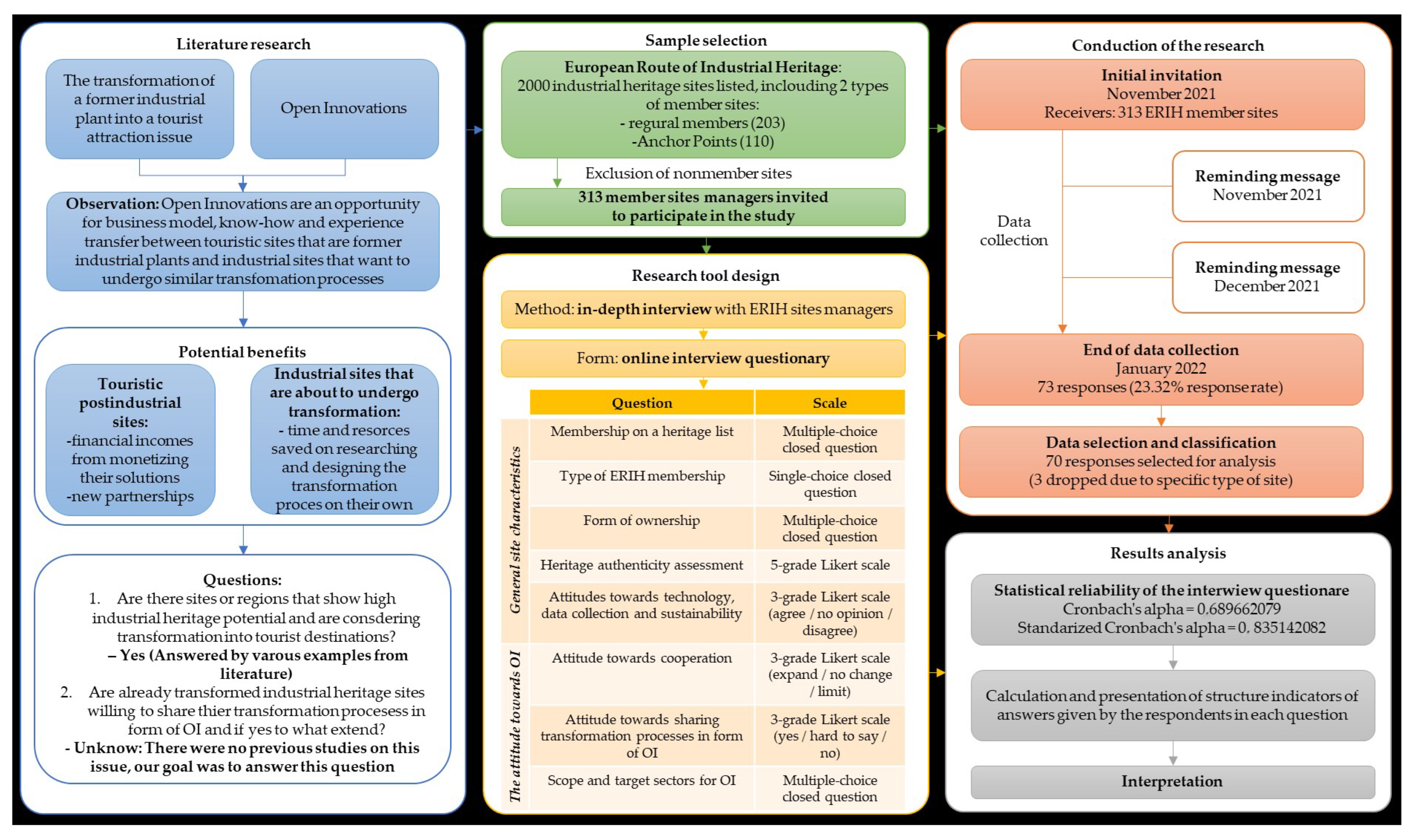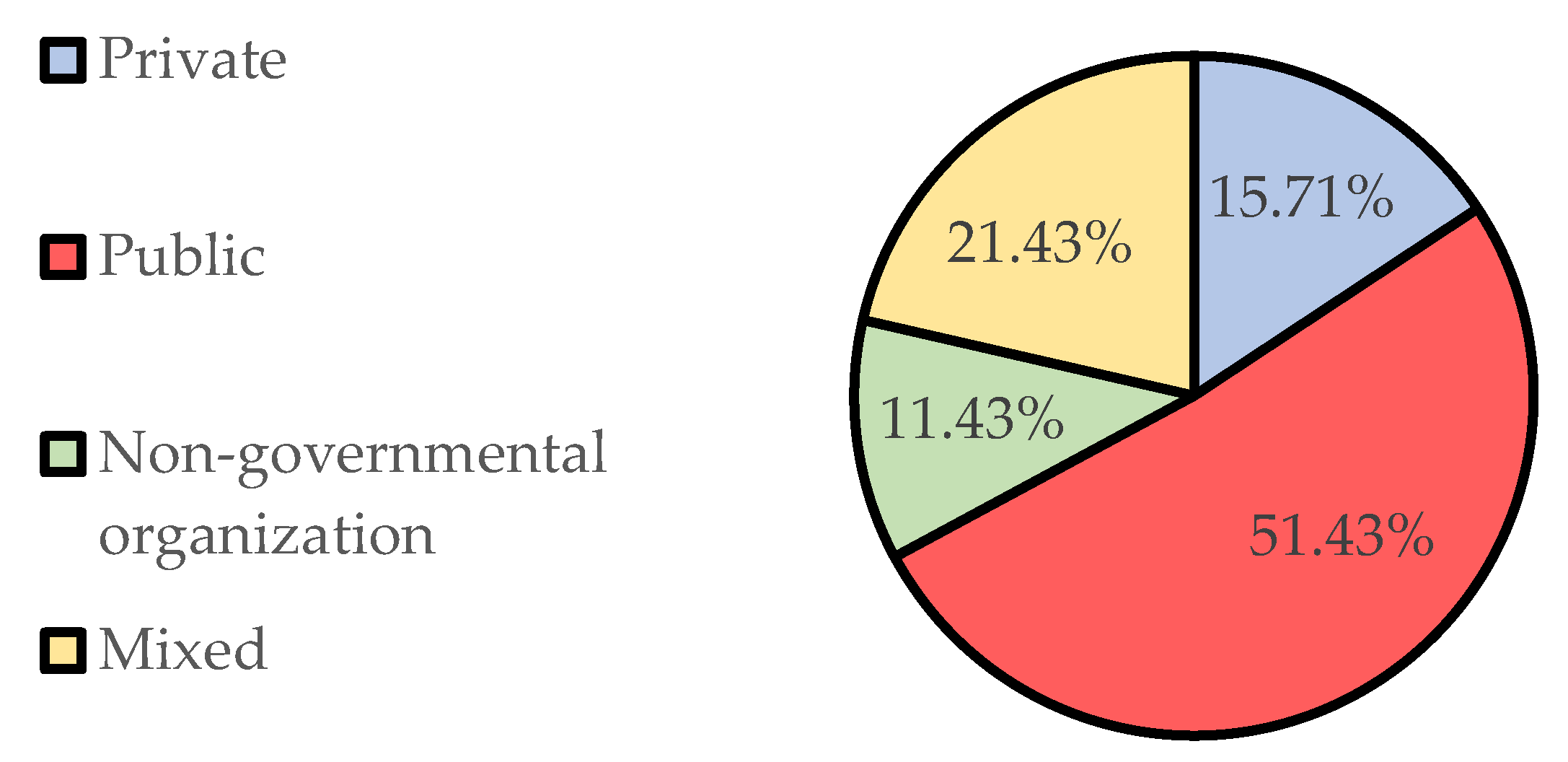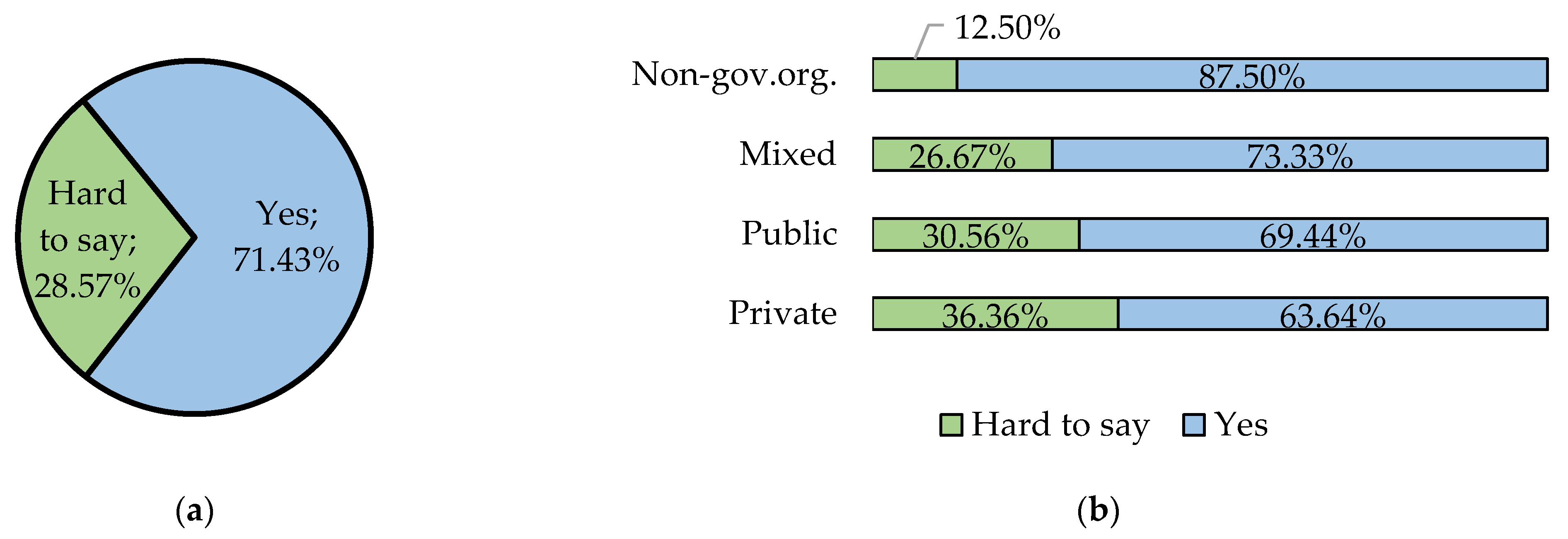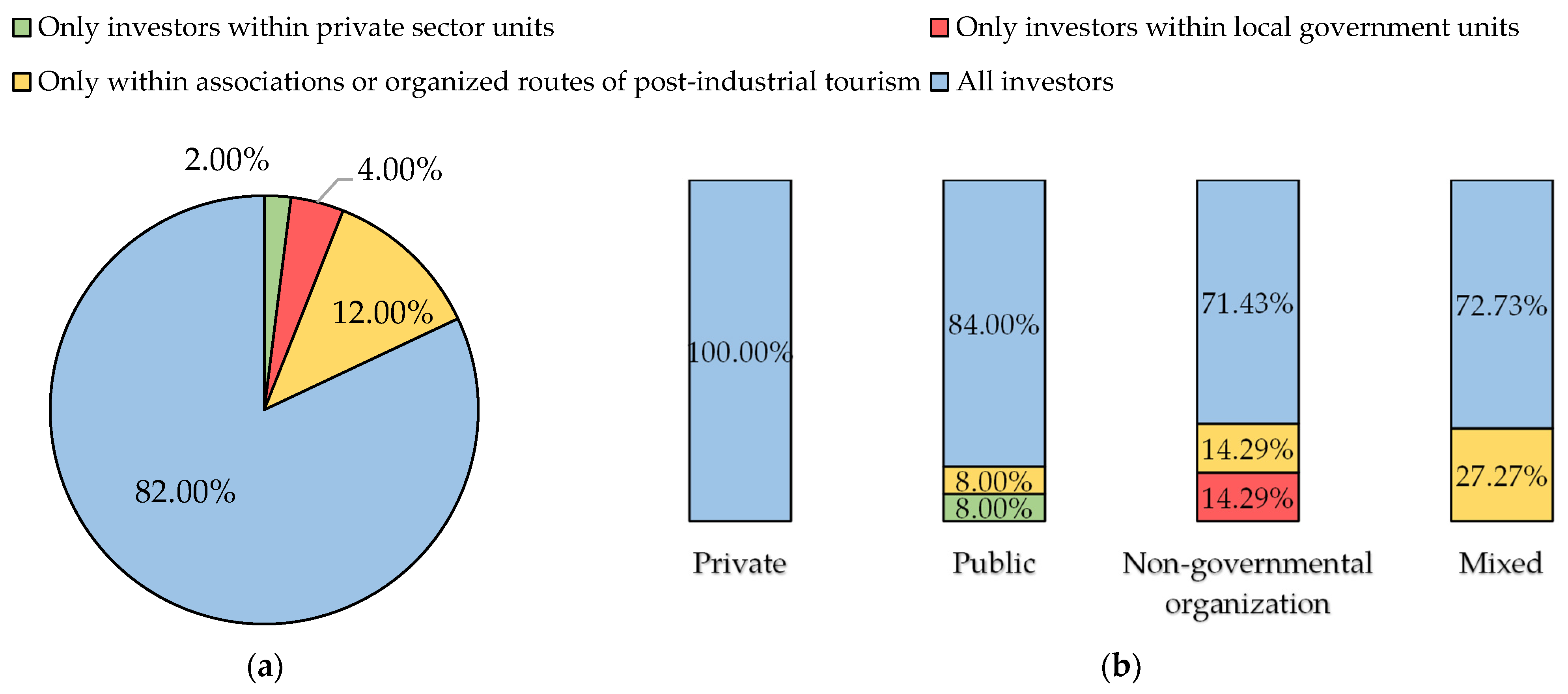The Transformation Process of a Former Industrial Plant into an Industrial Heritage Tourist Site as Open Innovation
Abstract
:1. Introduction
- Outside-in—in this kind of process external knowledge is incorporated into the innovation processes. In other words, the experiences of partners, clients, and suppliers are used by an organization for more efficient change, and the new knowledge does not originate from within it.
- Inside-out—it is a reversed process of Outside-in open innovation, and it refers to the transfer of knowledge to entities outside the organization in which the knowledge was created.
- Coupled—where both inside-out and outside-in processes are carried out simultaneously.
- Outbound Non-pecuniary (Revealing)—sharing internal knowledge or innovation for free or without the expectation for long-term monetary wins.
- Outbound Pecuniary (Selling)—sharing internal knowledge or innovation via a contract with the intention of making financial profits.
- Inbound Non-pecuniary (Sourcing)—using external knowledge or intellectual property that is available for free.
- Inbound Pecuniary (Acquiring)—buying access to knowledge or innovations that are not publicly available.
2. The Issue of Transformation in Industrial Tourism as Open Innovation
- Post-production tourist organizations—Facilities that are former industrial plants and stopped their production in the past, before it was opened for tourists and currently carries out only the touristic function.
- ○
- Post-production tourist organizations with shifted tourism function—this a subtype of post-production tourist organizations, in which the production and tourist function overlapped in the past before the industrial facility became only a tourist attraction (without the pause between the two functions).
- Production and tourist enterprises—This type refers to historical production plants that still carry out production as their main function, but started to supplement it with touristic tours where visitors get to know the historical arts of crafting.
- ○
- Production and tourist enterprises with dominant tourist function—a subtype of the second type of production and tourist enterprises in which the tourist function became dominant over production and stayed so till the current day.
- ○
- Production and tourist enterprise with restarted productive function—a site in which similarly to post-production tourist organizations the productive function was ceased in the past and after some delay the touristic function took over, but in response to the victors need a small scale production of the original good was restarted (for demonstration or merchandising purposes).
- Tourist thematic organizations—a touristic site that has in its past never been a production facility but was rather from the start meant for touristic purposes (to present industrial heritage in form of exhibitions or artifact collection in a non-industry related building).
- ○
- The extended thematic tourism organization—just like the regular tourist thematic organizations these subtypes were constituted in a place that has no production history, but just like production and tourist enterprises with the restarted productive function, they introduced a production function in response to the tourists’ demands.
3. Materials and Methods
4. Results and Analysis
- Only investors within local government units to maintain state control over post-industrial heritage;
- Only investors within private sector units to increase the expansion of the tourism market;
- Only within associations or organized routes of post-industrial tourism, for maintaining service standards and increasing the efficiency of the revitalization of facilities
- All investors (state and private) for the development of cultural heritage.
5. Discussion and Concluding Remarks
- How to enable industrial heritage sites that are limited by public funds to peruse sustainability goals?—The suggested by our study answer would be: by monetizing the revitalization process and guidance programs for emerging postindustrial destinations in the form of OI could secure additional means that can be used for this purpose.
- How to find a new application for old unused industrial plants and how to conduct the change without experiencing the same problems that have been observed in previous cases?—The emerging answer would be to use the offered by already experienced destinations solutions, that would be available if the form of OI.
Author Contributions
Funding
Informed Consent Statement
Data Availability Statement
Acknowledgments
Conflicts of Interest
References
- Chesbrough, H.W. Open Innovation: The New Imperative for Creating and Profiting from Technology; Harvard Business Press: Boston, MA, USA, 2003. [Google Scholar]
- Aziz, E.; Mustapha, H. A bibliometric study of the recent advances in open innovation concept. Procedia Comput. Sci. 2020, 175, 683–688. [Google Scholar] [CrossRef]
- West, J.; Salter, A.; Vanhaverbeke, W.; Chesbrough, H. Open innovation: The next decade. Res. Policy 2014, 43, 805–811. [Google Scholar] [CrossRef]
- Christensen, J.F.; Olesen, M.H.; Kjær, J.S. The industrial dynamics of Open Innovation—Evidence from the transformation of consumer electronics. Res. Policy 2005, 34, 1533–1549. [Google Scholar] [CrossRef]
- Trzeciak, M.; Kopec, T.P.; Kwilinski, A. Constructs of Project Programme Management Supporting Open Innovation at the Strategic Level of the Organisation. J. Open Innov. Technol. Mark. Complex. 2022, 8, 58. [Google Scholar] [CrossRef]
- Carmona-Lavado, A.; Cuevas-Rodríguez, G.; Cabello-Medina, C.; Fedriani, E.M. Does open innovation always work? The role of complementary assets. Technol. Forecast Soc. Change 2021, 162, 120316. [Google Scholar] [CrossRef]
- Kazandzhieva, V. Potential for applying open innovations in tourism. Известия на Съюза на учените-Варна. Серия Икoнoмически науки 2019, 8, 28–36. [Google Scholar] [CrossRef]
- Dahlander, L.; Gann, D.M. How open is innovation? Res. Policy 2010, 39, 699–709. [Google Scholar] [CrossRef]
- Suhada, T.A.; Ford, J.A.; Verreynne, M.L.; Indulska, M. Motivating individuals to contribute to firms’ non-pecuniary open innovation goals. Technovation 2021, 102, 102233. [Google Scholar] [CrossRef]
- Chesbrough, H. Business model innovation: Opportunities and barriers. Long Range Plan. 2010, 43, 354–363. [Google Scholar] [CrossRef]
- Lu, Q.; Chesbrough, H. Measuring open innovation practices through topic modelling: Revisiting their impact on firm financial performance. Technovation 2021, 102434. Available online: https://www.sciencedirect.com/science/article/pii/S0166497221002157 (accessed on 1 March 2022). [CrossRef]
- Marullo, C.; Ahn, J.M.; Martelli, I.; Di Minin, A. Open for innovation: An improved measurement approach using item response theory. Technovation 2022, 109, 102338. [Google Scholar] [CrossRef]
- Barbic, F.; Jolink, A.; Niesten, E.; Hidalgo, A. Opening and closing open innovation projects: A contractual perspective. Ind. Mark. Manag. 2021, 94, 174–186. [Google Scholar] [CrossRef]
- Chesbrough, H.W. Environmental influences upon firm entry into new sub-markets: Evidence from the worldwide hard disk drive industry conditionally. Res. Policy 2003, 32, 659–678. [Google Scholar] [CrossRef]
- Chesbrough, H. To recover faster from Covid-19, open up: Managerial implications from an open innovation perspective. Ind. Mark. Manag. 2020, 88, 410–413. [Google Scholar] [CrossRef]
- Della Corte, V.; Del Gaudio, G.; Sepe, F.; Sciarelli, F. Sustainable tourism in the open innovation realm: A bibliometric analysis. Sustainability 2019, 11, 6114. [Google Scholar] [CrossRef] [Green Version]
- Del Vecchio, P.; Mele, G.; Ndou, V.; Secundo, G. Open innovation and social big data for sustainability: Evidence from the tourism industry. Sustainability 2018, 10, 3215. [Google Scholar] [CrossRef] [Green Version]
- Gusakov, A.A.; Haque, A.U.; Jogia, A.V. Mechanisms to support open innovation in smart tourism destinations: Managerial perspective and implications. Pol. J. Manag. Stud. 2020, 21, 142–161. [Google Scholar] [CrossRef]
- Iglesias-Sánchez, P.P.; Correia, M.B.; Jambrino-Maldonado, C. Challenges of open innovation in the tourism sector. Tour. Plan. Dev. 2019, 16, 22–42. [Google Scholar] [CrossRef]
- Pikkemaat, B.; Peters, M. Open innovation: A chance for the innovation management of tourism destinations? In Open Tourism; Springer: Berlin/Heidelberg, Germany, 2016; pp. 153–169. [Google Scholar]
- Szromek, A.R. Transformation of Business Models in Spa Enterprises for Medical Purposes in Situations of Epidemic Threats. JOItmC 2021, 7, 143. [Google Scholar] [CrossRef]
- Bangstad, T. Routes of industrial heritage: On the animation of sedentary objects. Cult. Unbound 2011, 3, 279–294. [Google Scholar] [CrossRef] [Green Version]
- Szromek, A.R.; Naramski, M. Measuring trust in business relations between tourist facilities on one thematic touristic route. Sustainability 2019, 11, 3935. [Google Scholar] [CrossRef] [Green Version]
- Garrod, B.; Fyall, A. Managing heritage tourism. Ann. Tour. Res. 2000, 27, 682–708. [Google Scholar] [CrossRef]
- Wells, V.K.; Manika, D.; Gregory-Smith, D.; Taheri, B.; McCowlen, C. Heritage tourism, CSR and the role of employee environmental behaviour. Tour. Manag. 2015, 48, 399–413. [Google Scholar] [CrossRef] [Green Version]
- Yu Park, H. Heritage tourism: Emotional journeys into nationhood. Ann. Tour. Res. 2010, 37, 116–135. [Google Scholar] [CrossRef]
- Timothy, D.J. Making sense of heritage tourism: Research trends in a maturing field of study. Tour. Manag. Perspect. 2018, 25, 177–180. [Google Scholar] [CrossRef]
- Lim, S.T.; Preis, M.W.; Lee, C.K.; Mangematin, V.; Kim, M.J. The influence of open innovation activities on non-financial performance in the cultural tourism content industry. Curr. Issues Tour. 2021, 24, 1340–1344. [Google Scholar] [CrossRef]
- Ball, R. Industrial Heritage, Tourism and old Industrial Building: Charting the Difficult Path from Redundancy to Heritage Attraction; The Royal Institution of Chartered Surveyors: London, UK, 1997; Available online: https://www.csu.edu/cerc/researchreports/documents/IndustrialHeritageTourismOldIndustrialBuildings1997.pdf (accessed on 1 March 2022).
- Szromek, A.R.; Herman, K.; Naramski, M. Sustainable development of industrial heritage tourism–A case study of the Industrial Monuments Route in Poland. Tour. Manag. 2021, 83, 104252. [Google Scholar] [CrossRef]
- Ćopić, S.; ĐorđevićA, J.; Lukić, T.; Stojanović, V.; Đukičin, S.; Besermenji, S.; Stamenković, I.; Tumarić, A. Transformation of industrial heritage: An example of tourism industry development in the Ruhr area (Germany). Geogr. Pannonica 2014, 18, 43–50. [Google Scholar] [CrossRef] [Green Version]
- Naramski, M. The Application of ICT and Smart Technologies in Polish Museums—Towards Smart Tourism. Sustainability 2020, 12, 9287. [Google Scholar] [CrossRef]
- Chhabra, D. Proposing a sustainable marketing framework for heritage tourism. J. Sustain. Tour. 2009, 17, 303–320. [Google Scholar] [CrossRef]
- Cole, D. Exploring the sustainability of mining heritage tourism. J. Sustain. Tour. 2004, 12, 480–494. [Google Scholar] [CrossRef]
- Van der Merwe, C.D.; Rogerson, C.M. Industrial heritage tourism at the ‘Big Hole’, Kimberley, South Africa. Afr. J. Phys. Health Educ. Recreat. Danc. 2013, 19 (Suppl. S3), 155–171. [Google Scholar]
- Hashimoto, A.; Telfer, D.J. Transformation of Gunkanjima (Battleship Island): From a coalmine island to a modern industrial heritage tourism site in Japan. J. Herit. Tour. 2017, 12, 107–124. [Google Scholar] [CrossRef]
- Gassmann, O.; Enkel, E.; Chesbrough, H. The future of open innovation. R D Manag. 2010, 40, 213–221. [Google Scholar] [CrossRef]
- Huizingh, E.K. Open innovation: State of the art and future perspectives. Technovation 2011, 31, 2–9. [Google Scholar] [CrossRef]
- De Oliveira, L.S.; Echeveste, M.E.; Cortimiglia, M.N. Critical success factors for open innovation implementation. J. Organ. Change Manag. 2018, 31, 1283–1294. [Google Scholar] [CrossRef]
- Gray, C. Absorptive capacity, knowledge management and innovation in entrepreneurial small firms. Int. J. Entrep. Behav. Res. 2006, 12, 345–360. [Google Scholar] [CrossRef]
- Yeşil, S.; Koska, A.; Büyükbeşe, T. Knowledge sharing process, innovation capability and innovation performance: An empirical study. Procedia Soc. Behav. Sci. 2013, 75, 217–225. [Google Scholar] [CrossRef] [Green Version]
- Gebauer, H.; Worch, H.; Truffer, B. Absorptive capacity, learning processes and combinative capabilities as determinants of strategic innovation. Eur. Manag. J. 2012, 30, 57–73. [Google Scholar] [CrossRef]
- Cizler, J.; Pizzera, J.; Fischer, W. Industrial heritage as a potential for redevelopment of post-industrial areas in Austria. AGG+ J. Archit. Civ. Eng. Geod. Relat. Sci. Fields 2015, 2, 52–56. [Google Scholar] [CrossRef] [Green Version]
- Belláková, E. Analysis of industrial architectural heritage–iron and steel plants as a development potential. Procedia Eng. 2016, 161, 1926–1931. [Google Scholar] [CrossRef] [Green Version]
- Metsaots, K.; Printsmann, A.; Sepp, K. Public opinions on oil shale mining heritage and its tourism potential. Scand. J. Hosp. Tour. 2015, 15, 380–399. [Google Scholar] [CrossRef]
- Chatterjee, R.; Dupre, K. Exploring newcastle’s potential as an industrial heritage tourism destination. J. Tour. 2019, 5, 31–50. [Google Scholar] [CrossRef]
- Xie, P.F. Developing industrial heritage tourism: A case study of the proposed jeep museum in Toledo, Ohio. Tour. Manag. 2006, 27, 1321–1330. [Google Scholar] [CrossRef]
- Van der Merwe, C.D.; Rogerson, C.M. The local development challenges of industrial heritage in the developing world: Evidence from Cullinan, South Africa. Geoj. Tour. Geosites 2018, 21, 186–199. [Google Scholar]
- Givental, E.; Stepanov, A.V.; Ilyushkina, M.Y.; Burnasov, A.S. The post-industrial landscapes of Central Urals, Russia: Heritage value, tourist potential, and unrealized opportunities. Reg. Res. Russ. 2019, 9, 193–203. [Google Scholar] [CrossRef]
- Martinović, A.; Ifko, S. Industrial heritage as a catalyst for urban regeneration in post-conflict cities Case study: Mostar, Bosnia and Herzegovina. Cities 2018, 74, 259–268. [Google Scholar] [CrossRef]
- ERIH Website. Available online: https://www.erih.net/ (accessed on 1 June 2021).
- Nemoto, T.; Beglar, D. Developing Likert-scale questionnaires. In Proceedings of the JALT2013 Conference, Kobe, Japan, 25–28 October 2013; Sonda, N., Krause, A., Eds.; JALT: Tokyo, Japan, 2014. [Google Scholar]
- Joshi, A.; Kale, S.; Chandel, S.; Pal, D.K. Likert scale: Explored and explained. Br. J. Appl. Sci. Technol. 2015, 7, 396. [Google Scholar] [CrossRef]
- Boone, H.N.; Boone, D.A. Analyzing likert data. J. Ext. 2012, 50, 2TOT2. [Google Scholar]
- ERIH. ERIH Covid-19 #Stayathome Measures ERIH Sites: Results of an Ad-Hoc Online Survey Implemented in April 2020, n = 50. Available online: https://www.erih.net/fileadmin/Mediendatenbank/Downloads/7_SERVICE/SERVICE_DOWNLOADS/Survey/Corona/Covid-19_Social_Media_Measures_ERIH_Online_Survey_english_.pdf (accessed on 1 January 2022).
- ERIH. The Evaluation of ERIH’s Activities Financed by the Creative Europe Programme during 2014–2017. The Summary of the Results of the Printed and the Online Poll. Available online: https://www.erih.net/fileadmin/Mediendatenbank/Downloads/7_SERVICE/SERVICE_DOWNLOADS/Survey/Evaluation_of_printed_and_online_survey_ERIH_2017.pdf (accessed on 1 January 2022).
- Buhalis, D.; Amaranggana, A. Smart Tourism Destination. In Information and Communication Technologies in Tourism; Xiang, Z., Tussyadiah, I., Eds.; Springer International Publishing: Cham, Switzerland, 2014; pp. 553–564. [Google Scholar]
- Boes, K.; Buhalis, D.; Inversini, A. Smart tourism destinations: Ecosystems for tourism destination competitiveness. Int. J. Tour. Cities 2016, 2, 108–124. [Google Scholar] [CrossRef]
- La Rocca, R.A. The Role of Tourism in Planning the Smart City. TeMA J. Land Use Mobil. Environ. 2014, 7, 269–284. [Google Scholar]
- Gretzel, U.; Werthner, H.; Koo, C.; Lamsfus, C. Conceptual foundations for understanding smart tourism ecosystems. Comput. Hum. Behav. 2015, 50, 558–563. [Google Scholar] [CrossRef]
- Naramski, M.; Szromek, A.R.; Herman, K.; Polok, G. Assessment of the Activities of European Cultural Heritage Tourism Sites during the COVID-19 Pandemic. J. Open Innov. Technol. Mark. Complex. 2022, 8, 55. [Google Scholar] [CrossRef]







| Type of Heritage List | Share |
|---|---|
| UNESCO | 12.86% |
| National Tentative List | 22.86% |
| None | 64.28% |
| Type Membership | Share |
| Anchor Point | 40% |
| Regular member | 60% |
Publisher’s Note: MDPI stays neutral with regard to jurisdictional claims in published maps and institutional affiliations. |
© 2022 by the authors. Licensee MDPI, Basel, Switzerland. This article is an open access article distributed under the terms and conditions of the Creative Commons Attribution (CC BY) license (https://creativecommons.org/licenses/by/4.0/).
Share and Cite
Naramski, M.; Herman, K.; Szromek, A.R. The Transformation Process of a Former Industrial Plant into an Industrial Heritage Tourist Site as Open Innovation. J. Open Innov. Technol. Mark. Complex. 2022, 8, 74. https://doi.org/10.3390/joitmc8020074
Naramski M, Herman K, Szromek AR. The Transformation Process of a Former Industrial Plant into an Industrial Heritage Tourist Site as Open Innovation. Journal of Open Innovation: Technology, Market, and Complexity. 2022; 8(2):74. https://doi.org/10.3390/joitmc8020074
Chicago/Turabian StyleNaramski, Mateusz, Krzysztof Herman, and Adam R. Szromek. 2022. "The Transformation Process of a Former Industrial Plant into an Industrial Heritage Tourist Site as Open Innovation" Journal of Open Innovation: Technology, Market, and Complexity 8, no. 2: 74. https://doi.org/10.3390/joitmc8020074
APA StyleNaramski, M., Herman, K., & Szromek, A. R. (2022). The Transformation Process of a Former Industrial Plant into an Industrial Heritage Tourist Site as Open Innovation. Journal of Open Innovation: Technology, Market, and Complexity, 8(2), 74. https://doi.org/10.3390/joitmc8020074







